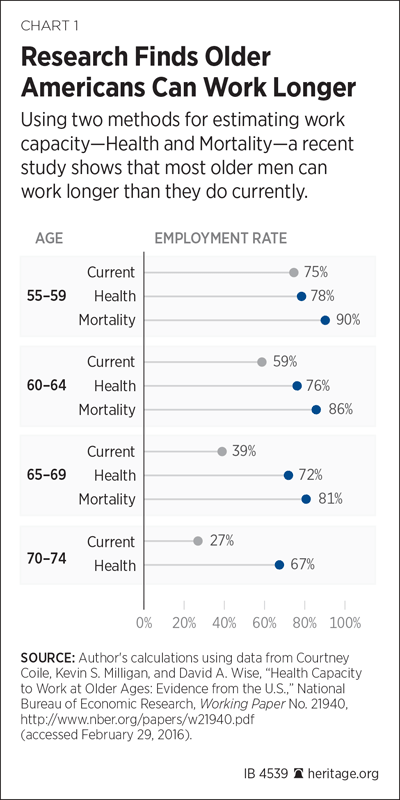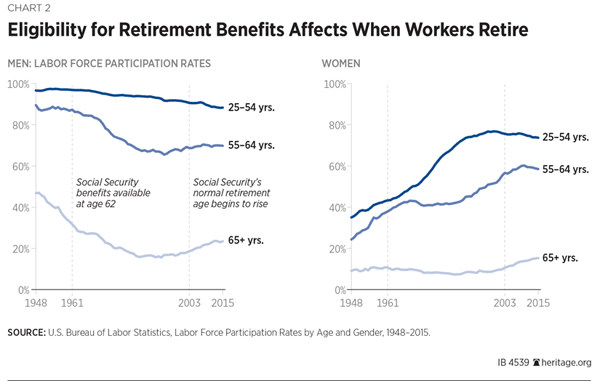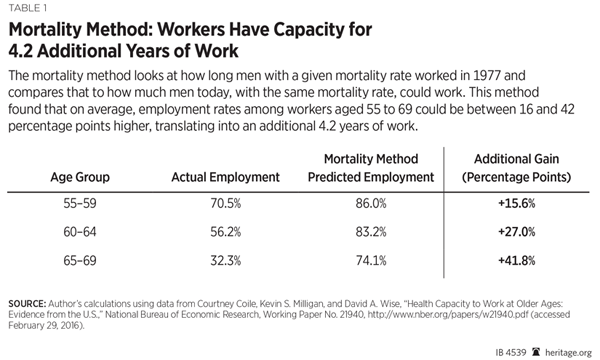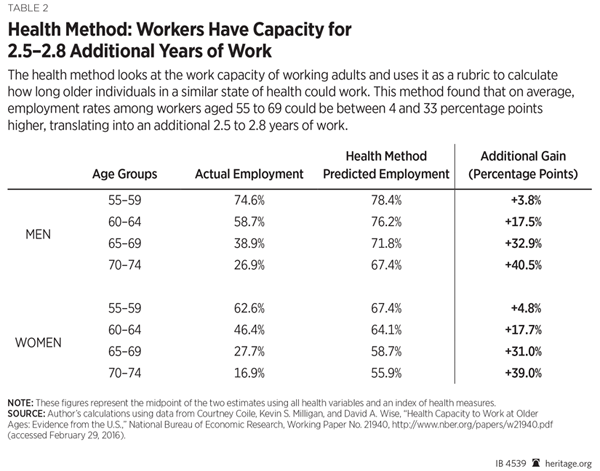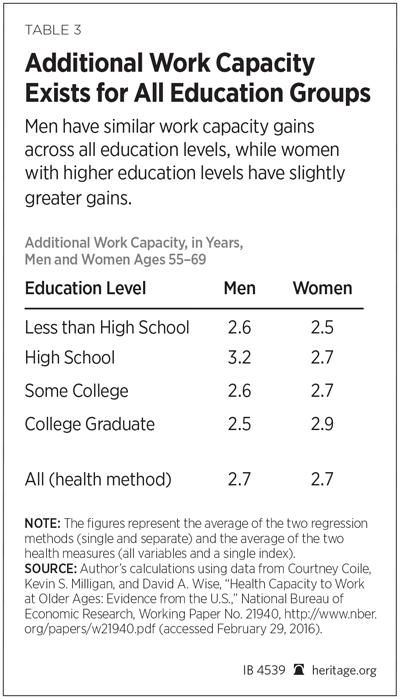A new study from the National Bureau of Economic Research (NBER) estimates that Americans can work significantly longer than they currently do.[1] According to the study, Americans could work an additional 2.5 years to 4.2 years on average between the ages of 55 and 69. This is equivalent to a 30 percent to 50 percent increase in employment among this age group.
This is welcome news for America’s massively underfunded entitlement programs and pension plans because increasing eligibility ages is the logical response to higher life expectancies. Raising eligibility ages would help to contain costs and preserve the original intent of entitlements and pensions: to provide for individuals who can no longer work. The NBER study alleviates concerns that Americans are unable to work longer and suggests that raising eligibility ages is a commonsense solution for underfunded entitlements and pension plans.
Two Methods, Similar Conclusion
The NBER study examines the health capacity of Americans to work longer in light of increased life expectancies, using two diverse methods to estimate additional work capacity. The study concludes that individuals from 55 to 69 years of age could work an additional 2.5 years to 4.2 years, or 30 percent to 50 percent more than the current 7.9 years they work during these ages.[2]
The first method (the mortality method, referred to in the study as the Milligan–Wise method), examines how much older Americans would work if they worked at the same rate as previous generations of Americans who had the same mortality rates[3] worked. The study compares older workers in 2010 to younger workers in 1977 who had the same mortality rates.
Using the results of the study as an example, this method says that if individuals who were 65 years old in 2010 were to work at the same rate as individuals with their same mortality rate in 1977, employment among 65-year-olds in 2010 would have more than doubled, from 36.6 percent to 77.4 percent. The mortality method focuses exclusively on men because the significant rise in women’s labor force participation from 1977–2010 makes it difficult to interpret the results among women.
The second method (the health method, referred to in the study as the Cutler et al. method) examines how much older Americans could work if they were employed at the same rates as slightly younger workers (ages 51 to 54) who have similar health characteristics. This method uses data from the Health and Retirement Survey (HRS) to examine the relationship between health and employment among individuals ages 51–54 who are still many years away from Social Security eligibility. The authors then use this information to predict the work capacity of individuals who are 55–74, based on their health. The authors include two different health measures. The first separately includes all 27 questions from the health survey, and the second composes a single health index based on the 27 questions.
For example, this method finds that employment among men ages 65–69 would increase from 38.9 percent to 73.2 percent using all of the health variables and to 70.4 percent using the health index. These findings represent respective increases in employment of 34.2 percentage points and 31.4 percentage points.
Labor Market Trends for Older Americans
Labor force participation rates among individuals, both male and female, 55 and older have varied significantly over time. For men, labor force participation among men ages 55 to 64 peaked in 1948 at 90 percent and declined to a low of 66 percent in 1994 before rising to the current 2015 level of 70 percent.[4] Men 65 and older followed a similar trend but at lower participation rates, peaking at 47 percent in 1948, declining to 16 percent in 1993, and moving up to 23 percent in 2015.
The decline in labor force participation among older men has been attributed in large part to more widespread and generous Social Security and defined-benefit pensions. These benefits often give individuals strong incentives to stop working at certain ages, irrespective of their work capacity. Evidence suggests that, absent these age-based retirement benefit programs, individuals could and would work significantly longer. Moreover, defined-contribution retirement accounts contain the incentive to remain employed longer because work provides the opportunity for additional contributions and more time for savings to grow in value.
It is difficult to determine the effect of retirement benefits on older women’s labor force participation rates because participation rates for women of all ages were generally increasing during much of this period.
Findings
Using the Milligan–Wise mortality method, the authors estimate that men could work an additional 4.2 years, on average, between the ages of 55 and 69.[5] This is more than a 50 percent increase in work compared to the 7.9 years that men between the ages of 55 and 69 currently work.
If the same relationship between mortality and employment that existed in 1977 were in effect in 2010, employment would be 16 percentage points higher among men ages 55–59, 27 percentage points higher between ages 60 and 64, and 42 percentage points higher between ages 65 and 69.
Using the Cutler et al. health assessment method, the authors estimate that men would work an additional 2.5 years to 2.8 years between the ages of 55 and 69. If the same relationship between health and employment that exists among younger workers also existed among older workers, employment would rise by 4 percentage points among men ages 55 and 59, 18 percentage points between ages 60 and 64, 33 percentage points between ages 65 and 69, and 40 percentage points between ages 70 and 74.[6]
For women, the employment gains would be 5 percentage points between ages 55 and 59, 18 percentage points between ages 60 and 64, 31 percentage points between ages 65 and 69, and 39 percentage points between ages 70 and 74.
In both cases, potential work gains are highest among the oldest individuals, for whom labor force participation is currently very low. As a whole, this study implies that employment rates among older Americans would be significantly higher today in the absence of age-based retirement benefits such as Social Security, Medicare, and pensions.
Does Education Affect Additional Work Capacity?
Within a given age group, certain individuals, such as those with higher incomes, may have greater additional work capacity than others. Thus, the authors use education to explore differences in additional work capacity. Education is used as a proxy for income because incomes in older ages are often not indicative of average lifetime incomes.
The authors found no clear link between education and additional work capacity. Using the health index measure of health, the authors found an additional work capacity of 2.5 years for men with a college degree, 2.6 years for men with less than a high school education, and 3.2 years for men with a high school degree.[7]
There was, however, a small but significant difference in women’s work capacity by education. Women with a college degree had 3.1 years of additional work capacity, while high school graduates had 2.5 years and high school dropouts had 2.1 years of additional work capacity.
Raising Retirement Ages: A Logical Solution for Underfunded Entitlements and Pensions
When Social Security, Medicare, and many public and private pensions were established, their creators did not foresee the tremendous increases in life expectancy that have occurred. (When Social Security first began, for example, life expectancy was lower than the program’s eligibility age.) Consequently, these programs now subsidize decades-long retirements and encourage individuals to retire long before they can no longer work. Public and private pensions are typically even more generous, often providing individuals close to their full salary as early as age 50 or 55. Such lengthy and generous benefits are simply unsustainable.
Increasing contributions rates to continue such lengthy retirements is extremely costly. Congress has already more than doubled the 6 percent payroll tax rate that Americans were promised was “the most you will ever pay,” and keeping promised benefits will require an increase of another 21 percent.[8]
For many pensions, the required increases are impossible and would drive companies out of business. For example, one large underfunded union pension plan would have to more than quadruple its pension contributions to over $26 per union employee per hour worked, or $53,000 per year (on top of wages and all other benefits) just to pay promised pensions.[9]
It is not that workers should not be allowed to retire early if they choose to do so, but taxpayers and younger workers should not have to pay for the early retirement of other workers. Individuals who retire early should use their own private savings to do so.
According to the Congressional Budget Office (CBO), gradually increasing Social Security’s normal retirement age to 70, its early retirement age to 64, and Medicare’s eligibility age to 67 would reduce spending on these programs by 0.4 percent of gross domestic product (GDP) in 2035 and increase federal revenues by 0.5 percent of GDP, for a net decline in the deficit of about 1 percent of GDP (excluding the decline in interest payments).[10] By 2060, the cost savings would grow to 1 percent of GDP and the additional revenues would grow to 0.75 percent of GDP, for a total deficit reduction of 1.75 percent of GDP (excluding interest). In 2015, 1.75 percent of GDP was equal to $312 billion.
Higher revenues come from a larger labor force, which produces a larger economy. The CBO estimates that raising these retirement ages would increase both employment and GDP by 2 percent through 2035 and by almost 3 percent through 2060.[11]
Older Americans Can Work Longer
Policymakers should increase the eligibility ages for entitlements, and those who are responsible for setting pension benefits should raise eligibility ages. Increasing and indexing retirement ages to increases in life expectancy would help to return them to their original and limited purpose of providing for individuals when they can no longer work, and higher eligibility ages are crucial to preserving these programs for future generations.
As the NBER study shows, older individuals can work significantly longer. The government’s role should be limited to providing for individuals who cannot work, as opposed to subsidizing those who would prefer not to work. A more limited social insurance system would allow individuals to keep more of their incomes to save for the type of retirement they desire.
—Rachel Greszler is Senior Policy Analyst in Economics and Entitlements in the Center for Data Analysis, of the Institute for Economic Freedom and Opportunity, at The Heritage Foundation
